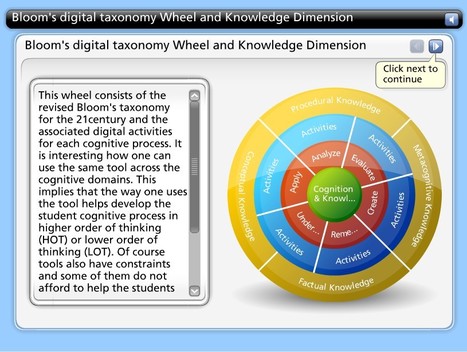
This is quite a clever and helpful device to tie together a large number of ideas about Bloom's Taxonomy in the Cognitive Domain. I highly recommend that interested readers visit the website and play with it. It's done quite well (although it would be even better if the few misspellings were attended to). Access it at http://eductechalogy.org/swfapp/blooms/wheel/engage.swf
But this gets me up on my soapbox because it highlights quite a significant oversight, in my opinion.
When Benjamin Bloom wrote his original work, he spoke of 3 domains, not just one. All 3 were, and are, of roughly equal importance in educating young people. The other 2 are the Affective Domain and the Psychomotor Domain. These correspond roughly to what, in today's parlance, might be called Social and Emotional Learning (Affective) and Mental and Physical Health (Psychomotor). Too much (or too little) emphasis on any one of the domains almost guarantees a lack of balance in childrens' learning and development. We can see this in the pejorative, hurtful names students call their peers when one of the domains assumes an unblanced priority over the others. Cognitive imbalance can lead to students being called eggheads or nerds, Affective imbalance to students being called geeks or loners, and Psychomotor imbalance to students being called dumb jocks or crazies.
It seems to me that the standards movement and the high-stakes testing movement have come to represent an educational environment that is seriously out of balance...with far too much emphasis on the Cognitive Domain, and too little on the Affective and Psychomotor. We have too many students who excel in one domain, and too few who are well rounded in two or three, as well as too many who do not reach their potential in any.
Furthermore, the emphasis on the separation of the Cognitive from the Affective and Psychomotor, has created structural imbalances in the operation of schools (read allocations of time, financial and material resources, personnel, and intellectual energy) that work to the detriment of our young people and our communities.The drive toward home schooling and charter schools can be viewed as two manifestations of this structural imbalance...increasing numbers of parents view schools (especially public ones) as unsuitable places to send their children and clamor for alternatives that offer a better balance among the 3 domains.
This is a great graphic organizeer, but it represents only an exaggeratedly large part of a much more important whole. -JL
Via Gust MEES, Paulo Simões, Shary Lyssy Marshall, Lynnette Van Dyke, Freddy Håkansson, Katharina Kulle, Rui Guimarães Lima, Jim Lerman



 Your new post is loading...
Your new post is loading...







http://eductechalogy.org/swfapp/blooms/wheel/engage.swf
Interactive animation that breaks down the 'wheel' - includes suggested 'tools' that could be used for different related activities.
A tad skeuomorphic for my tastes but the thinking behind it, is great…
Para el diseño de actividades y determinación de RED.